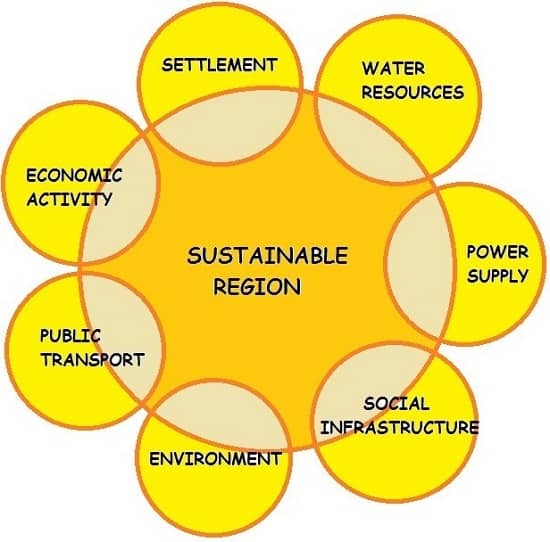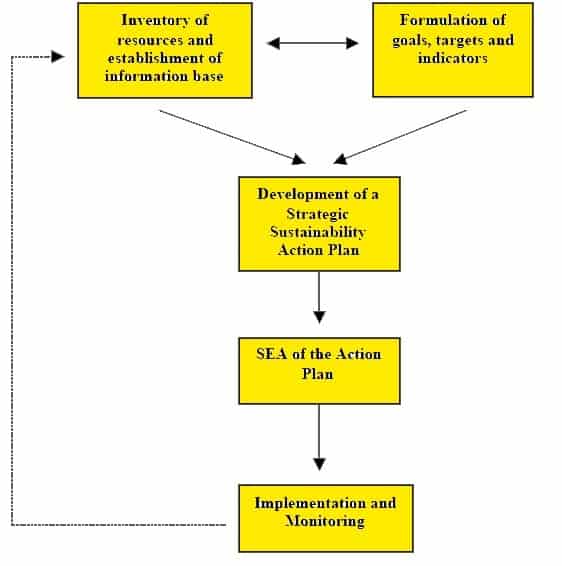The guidelines are in two forms: the guidelines on integration of sustainability with planning process and guidelines for evaluating the development plan. That is, both the planning process and the plan should be guided and evaluated for sustainability. The guideline on integration of sustainability with the planning process is based on the extension of the Strategic Environmental Assessment (SEA).
Apart from the having a framework for integrating sustainability into the planning process, there is also the need to assess the effectiveness of the planning process in promoting sustainability.
Three tasks that should be accomplished by an effective Environmental Assessment process:
- The process should identify the sustainability or environmental ramifications of implementing the strategic action and suggest possible changes.
- The changes recommended by the process have to make strategic actions and plans more sustainable.
- The changes should be incorporated in strategic actions and plans.
Guidelines of Integrating SEA into the planning process
Guidelines of integrating SEA into Planning Framework
| Procedure | Methodology | Policy |
| SEA should be flexible and adaptable process | (focus on sustainability) Interdisciplinary and participatory approach |
Adaptable to different contexts of policy development |
| The process should be participative | · Linkages b/w env, socio-economic issues should be clarified.
· SEA methodology should be adaptable to different contextual dimensions
|
Considering both direct and indirect effects of policies |
| SEA is independent but interlinked with the planning process | ||
| SEA should be within the context of alternative scenarios | Quantitative and qualitative assessment of plans, programs and policies |
Guidelines for evaluating Development Plan
Different attempts have been made to develop a quantitative and systematic approach for evaluating sustainable development principles in development plans.
A qualitative approach can be used to assess the strengths and weaknesses of development plans in terms of sustainable development.
The approach is mainly qualitative and seven plan elements are highlighted which are assessed on the principle of sustainable development. The plan elements are housing, transportation, environment, energy, land use, economic development and public facilities. (at regional level – settlement, water resources ,power supply, social infra, environment, public transport, economic activity)
An effective and comparable assessment of the development plan can be achieved if the approach is quantitative. The selected sustainability indicators should be measurable on all the development plans that are considered and a measurable relationship between the indicators and the plan elements should be established.

Guidance for Sustainable Development Plan & Structure of Sustainable Development Plan
Having highlighted the guiding principles for evaluating the development plan and integration of sustainability in the planning process, it is very important to elaborate on the components of a sustainable development plan and how these components could be explored to promote sustainability. As it has been recognized that there is a linkage between the planning process and the actual plan, the planning process must be guided by the principles of integration of sustainability for the development plan to be sustainable.
The institutional framework should effectively link planning and administration at the national, regional and local level thereby promoting coherence in policy and decision-making. The framework should be capable of promoting good governance, transparency and inclusive community participation.
The guidelines of sustainability integrated planning process could be complemented by the guidance for the development plan. The steps included in the procedure are:-
- Inventory of resources and establishment of information base – This step involves the collection of data on the quality of the environment. The baseline profile of natural, social and economic resources is established and information base on the current state of the environment is developed.
- Formulation of goals, targets and indicators – Sustainability goals is formulated after effective consultation with the public and institutions. The goals statements express the commitment of the development plan to pursue sustainable development.
- Development of a strategic sustainability action plan – Based on the formulated goals and targets, a strategic sustainability action plan is developed. The strategic sustainability plan outlines actions to achieve sustainability. The strategic plan states the priorities in achieving sustainability base on adequate analysis of inventory data and information.
- Strategic environmental assessment of the plan – The strategic sustainability plan is subjected to strategic environmental assessment to ensure that significant environmental effects of the plan are taken into account. Alternative scenarios are assessed and the best course of action is selected with recommendations on mitigating the likely environmental effects.
- Implementation and monitoring – The strategic sustainability action plan is implemented with adequate monitoring and evaluation. The evaluation is carried out by analyzing the data and information collected on the identified sustainability indicators. Obstacles to the implementation are identified and resolved. Changes in the components of the action plan are identified and documented to form the basis for the inventory of resources for future strategic sustainability plan.

The structure of sustainable development plan is similar to that of any other development plan, but for a sustainable development plan strategic environmental assessment is done independently and linked with the planning process to achieve a sustainably developed region/city.
Disclaimer: This article forms a part of report made by students of School of Planning & Architecture, New Delhi. The content published is not owned by Planning Tank and belongs to it’s author. It was submitted by one of our user and provided for educational purpose only.